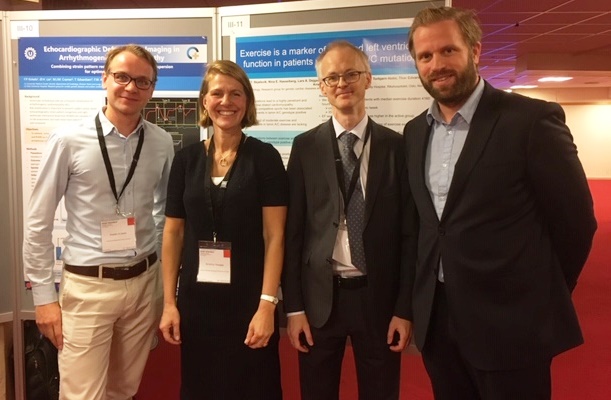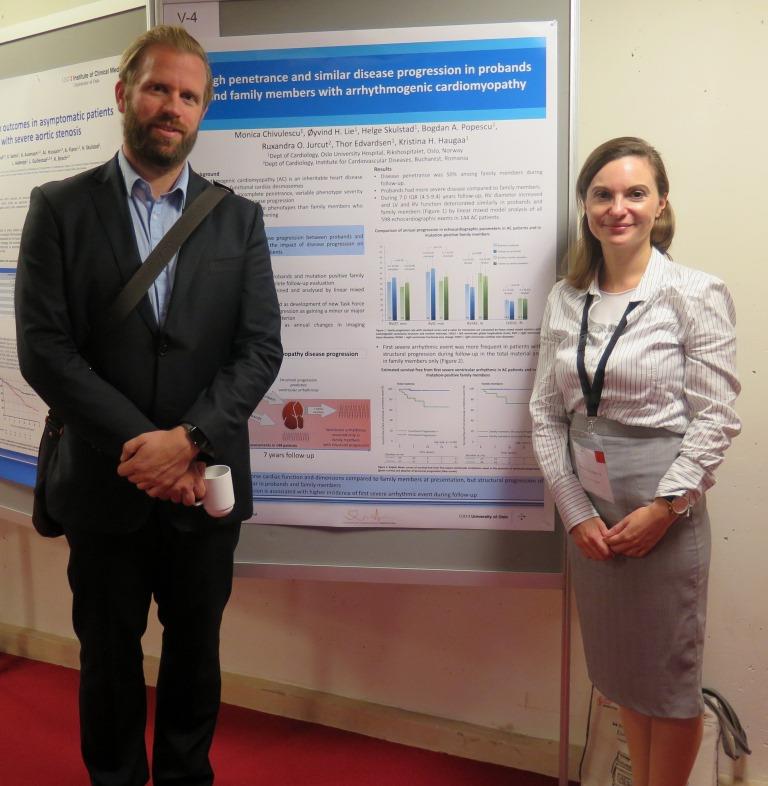18th Annual CHFR Symposium on Heart Research
The Center for Heart Failure Research (CHFR) was established in 2002 and has since then promoted the integration of high quality research from bench to bedside. Center members have a broad range of expertise, covering state-of-the-art gene technology, protein function, integrative physiology in pathophysiological models and clinical studies. This collective knowledge and active research collaboration has resulted in more than 200 scientific publications each year.
Several members of the Cardiac genetic diseases and sudden cardiac death research group presented interesting results from their recent studies. Two PhD fellows were awarded with the best poster prize; Eystein Skjølsvik for his work on “Exercise is a marker of impaired left ventricular function in patients with Lamin A/C mutations” and Monica Chivulescu for her work on “High penetrance and similar disease progression in probands and family members with arrhythmogenic cardiomyopathy”.
The later study was first published at the ESC Congress a month ago, in additon to being featured in Dagens Medisin, a Norwegian news outlet focusing on healthcare. In the interwiev with Dagens Medisin professor Kristina Haugaa tells that the results from this study suggest that family members of patients with ARVC should receive closer follow-up than they do now. Consultant Cardiologist Pål Tande from UNN (University Hospital of North Norway) agrees with prof. Haugaa that the study is a good argument for systematic screening of family members of patients with ARVC.
Previous best poster prize winner in the session Diagnostic and therapeutical strategies for cardiac disease postdoctoral fellow Øyvind H. Lie, was among the speakeres at this year's Symposium. Lie talked about Cardiac arrest in sports: Knowledge and misconceptions. Øyvind H. Lie has also written about the subject in, among others, Indremedisineren and Aftenposten.
The third session «Cardiac function during heart failure and exercise training», moderated by Øyvind Ellingsen and Ole-Jakob How, focused, as always, on the impact of exercise in heart failure.
Winning the best poster pricz was Eystein Skjølsvik with his poster “Exercise is a marker of impaired left ventricular function in patients with Lamin A/C mutations”.
Authors: Skjølsvik ET, Hasselberg NE, Dejgaard LA, Lie ØH, Andersen K, Holm T, Edvardsen T, Haugaa KH
Competitive sports have been associated with adverse events in patients with lamin A/C mutations, but data on recreational exercise has been lacking. This study showed that systolic function was impaired in physically active lamin A/C patients, suggesting exercise restriction beyond competitive sports for this patient group.

Photo: Oslo University Hospital (OUS)
Echocardiographic deformation imaging in arrhythmogenic cardiomyopathy: Combining strain pattern recognition with mechanical dispersion for optimal risk stratification
Authors: Kirkels FP, Lie ØH, Cramer MJ, Edvardsen T, Asselbergs FW, Teske AJ, Haugaa KH
Echocardiographic strain pattern recognition and right ventricular mechanical dispersion (RVMD) are valuable indices in risk assessments of patients with arrhythmogenic cardiomyopathy (AC), but has never been externally validated and compared. Strain pattern recognition and RVMD are both useful in risk stratification in AC patients. Combining the methods improved risk stratification in high risk individuals for ventricular arrhythmias. Furthermore, a two-step approach, by calculating RVMD in cases with normal strain patterns, accurately identified low risk individuals.
The fifth session «Diagnostic and therapeutical strategies for cardiac disease», moderated by Helge Midtbø and Geir Øystein Andersen focused on new diagnostic methods for improved patient care. Winning the best poster price was Monica Chivulescu with her poster “High penetrance and similar disease progression in probands and family members with arrhythmogenic cardiomyopathy”.
Authors: Chivulescu M, Lie ØH, Popescu BA, Skulstad H, Edvardsen T, Jurcut RO, Haugaa K
The study concluded that disease penetrance was fairly high in family members both at inclusion and during follow-up. Rate of progression was similar in probands and family members with arrhythmogenic cardiomyopathy and structural progression was associated with higher incidence of severe arrhythmic event in arrhythmia free patients during follow-up.
This study was also mentioned in an ESC Cardio Talk during ESC Congress - the biggest cardiovascular event of the year, in addition to being covered by Dagens Medisin.

Photo: Oslo University Hospital (OUS)
Prevalence and clinical predictors of sleep apnea in patients with paroxysmal atrial fibrillation
Authors: Traaen GM, Øverland B, Aakerøy L, Hunt TE, Bendz C, Bredesen N, Sande L, Aakhus S, Hansen L, Ausen K, Steinshamn S, Anfinsen OG, Loennechen JP, Akre H, Gullestad L
Recent studies have suggested a strong association between sleep apnea (SA) and atrial fibrillation (AF). In this study AF population the prevalence of SA was 83%, which is several times higher compared to 16% in the general population. The high prevalence of SA detected in this study may indicate that SA is under-recognized in patients with AF.
MRI-based evaluation of regional hypertrophy in a mouse model of hypertrophic cardiomyopathy
Authors: Andreassen K, Rixon CL, Henriksen IM, Haugaa KH, Sjaastad I, Edvardsen T, Lunde IG, Stokke MK
Experimental mouse models of hypertrophic cardiomyopathy (HCM) provide important insight into HCM pathophysiology. The aim of this study was to develop an MRI-based protocol to determine regional hypertrophy in mice during disease progression. Customized software was developed to calculate maximum, minimum, and mean myocardial thickness, in addition to free wall and septum thickness, resulting in development of an MRI-based protocol for characterization of regional hypertrophy in a mouse model of HCM, which can be used for detection of HCM in mice.
